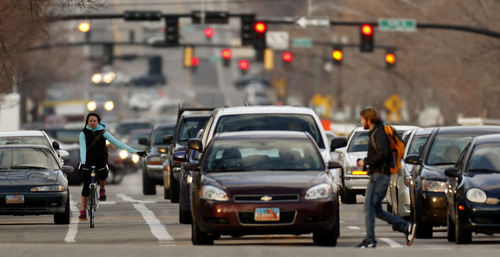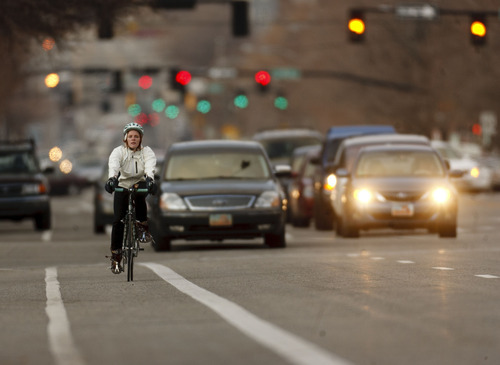This is an archived article that was published on sltrib.com in 2012, and information in the article may be outdated. It is provided only for personal research purposes and may not be reprinted.
A $25,000 grant to Salt Lake City will help traffic engineers test an innovative bike-safety tactic that uses parked cars to form a protected bike lane — a cost-effective move because construction will involve little more than green and white paint.
The funding from the Bikes Belong Foundation is a Best Practices grant, which the foundation administers for outdoor sports retailer REI. The goal is to showcase the best models from Europe and North America to help U.S. cities make riding a bike an easier, safer choice for short trips.
Salt Lake City was invited to apply for the grant because of the progress it has already made toward that goal, and because city residents seem to be embracing it — bicycle commutes have been found to have increased by 27 percent from 2010 to 2011.
Becka Roolf, who coordinates bike and pedestrian safety and access with the city's Transportation Division, said she went to Portland, Ore., for a study tour to examine how the concept works. The grant will cover the cost of adding the protected bike lane on a three-block stretch of 300 East, between 600 South and 900 South.
She imagines the lane as "low-stress, family friendly," Roolf said. "This is a test. We're going to be interested in getting as much input and feedback as we can before we apply it more broadly."
The road will be striped and painted with solid or cross-hatched segments that will move car parking away from the curb to make room for cyclists.
The bike lane will be striped and painted. A buffer zone will run along the parked cars' passenger sides, roughly the width of a car, so a passenger can step out of the vehicle without landing in the bike lane.
The buffer also makes it less likely a cyclist could be "doored," or collide with the car door as it's opened, a regular hazard for riders passing cars parked against street curbs.
Roolf said 300 East was a natural choice for the experiment because it is a wide street that already has a fair amount of bike traffic and low traffic volume, which makes it relatively noncontroversial. The project will require reconfiguration of traffic lanes. Pending the comments she expects to get from community councils, businesses and property owners, she said, the protected bike lane could be ready by June.
Lots of small details must be worked out, so city transportation officials will pause three times or so to evaluate the experiment, Roolf said. They need to work out how to mark intersections for the bike lanes, which she said would bring bikers out farther to the left so there can be a right-turn pocket for vehicles. They need to figure out how to paint the buffer zones and test snow removal and street sweeping on the route.
The Federal Highway Administration recently decreed that bike lanes should be painted green — the same color now used with temporary paint (which stubbornly remains, despite being water-based) to mark the city's marquee St. Patrick's, Utah Pride Festival and Days of '47 parade routes.
If necessary for cyclist safety, 4-inch-diameter flexible poles called delineator posts could be used as markers — other cities have done this, Roolf said — but they are expensive.
Creating the parked-car protected bike lane puts Salt Lake City in the company of Portland; San Francisco; Boulder, Colo.; Cambridge, Mass.; and Minneapolis. The grant is considered a national kudos to cities that have made progress toward being bike friendly.
"You create a safe place so more people will try [biking]," said Zoe Kircos, grants manager for Bikes Belong Foundation. "It's easier and safer for everyone — motorists, too." —
See a protected lane in Chicago
For an initial evaluation of protected bike lane created in 2011 in Chicago, visit http://bit.ly/wTRIRR. —
Salt Lake City ready to test protected byway
A $25,000 grant from the Bikes Belong Foundation, funded by outdoor recreation retailer REI, will create an innovative protected bike lane on 300 East between 600 South and 900 South that will be close to the street curb, with cars parked on the other side of a painted buffer zone. The city's Transportation Division will evaluate the project, the first protected lane to be built here, as it goes along.









